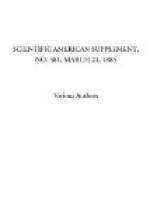An improvement has been made in the construction of the nippers. In the ordinary Heilmann’s comber, the upper blade has a groove in its nipping edge, and the cushion plate is covered with cloth and leather, the fibers being held by the grip between the leather of the cushion plate and the edges of the groove in the upper blade, or knife, as it is called. The objections to this mode of construction were that the leather on the cushion plate required frequent renewing, and unless the adjustment was more accurate than could always be relied on, the grip of the nippers was not perfect, for while at one end the nipper might be closed, at the other end it might be open wide enough to allow the cotton to be pulled through by the combing cylinder, and made into waste. In Messrs. Dobson and Barlow’s nipper there is neither cloth nor leather on the cushion plate. Its edge is made into a blunt ^, upon which the narrow flat surface of a strip of India rubber or leather fixed in the knife falls to give the nip. By this plan the cushion is applied to the knife instead of to the plate, which of course makes the cushion plate, after it has once been set, a fixture; it also dispenses with the accurate setting, as is now necessary in the old arrangement. It further does away with the frequent and expensive covering of the cushion-plate with roller leather and cloth, thus effecting a considerable saving, not only in cost of material, but also in labor, inasmuch as the nipper knives can be taken off, recovered, and replaced in one-sixth the time required to cover the cushion plates and replace them on the old system. American cotton of 7/8” staple to silk of 21/2” staple can also be combed by this improved arrangement, an achievement which has been attempted by many, but hitherto without arriving at any success. Messrs. Dobson and Barlow have however overcome the difficulty by their improvements, which combine three important qualities, viz., simplicity, perfection, and cheapness. Many hundreds




